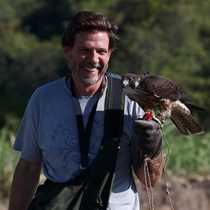Last night we crossed the national park boundaries of Glacier Bay. Unlike most wilderness areas, this national park includes the marine portion of the fjords, and the admission for vessels is carefully regulated. We picked up our park rangers before breakfast, and ventured north into the heart of Glacier Bay. First, we stopped to admire South Marble Island. This recently de-glaciated rock is ideal habitat for nesting birds. Tufted puffins, black-legged kittiwakes, common murres, black oystercatchers, glaucous-winged gulls and bald eagles were seen, among other bird species. We also saw a large group of Steller’s sea lions hauled up on the rocks, as steam rose into the air from their warm bodies.
Mountain goats are still found at low elevation this time of the year, before summer kicks in. The arrival of snow during the fall pushes mountain goat populations to areas where their food is not covered by snow. For most of the winter, goats move into the forests and leave the alpine elevations. Since the snow is still low, and the winter still lingers without wanting to depart, goats are still reluctant to move to higher elevations.
Just before Russell Cut, we spotted a lone wolf. This particular wolf was black, as is much of the wolf population in this area. We really consider ourselves lucky to see a wolf in the wild. These creatures are not only interesting, but they are true totemic beings, and remind us of the wild nature of Alaska’s wilderness.
After lunch we stopped to admire Grand Pacific and Margerie glaciers at the end of Tarr Inlet. These magnificent rivers of ice are remnants of past ice ages, which carved the landscape that we know today. With patience, we could hear the “white thunder” and see some of the large pieces of glacial ice fall from the face of Margerie Glacier.
On the way back south, the sun came out and turned the landscape into a true “winter wonderland.” The snow covered the mountains all the way down to the high tide line, and the denuded cottonwoods seemed impatient to wear their new leaves.
We had a good sighting of a very big coastal brown bear, which walked through the shore, just beneath the snow line. Although having just emerged from its winter den, it looked quite robust and wore a beautiful brown coat. Later in the evening, we had a great black bear sighting. This was the closest bear sighting so far, and we could clearly see the differences between the profiles of this black bear and the brown bear we had seen before.
We continued on to Bartlett Cove, where we had the opportunity to stretch our legs along the loop trail. We enjoyed the songs of the different thrushes in the forest as the day came to an end.









